
22 Jan – 3 Feb 2017. It is not an auspicious beginning in Valladolid. We’d looked repeatedly online for accommodation and all we came up with was a choice between a hotel for $1000 per night, or the guesthouse we ended up booking for $30 per night.
We know the guesthouse is only two or three blocks from the bus station so we push our cases along the rough crowded narrow sidewalks. Every second store it seems has a large speaker sitting in the doorway facing the street. “Music” rages forth from each one, distorted and thunderous. It both bewilders and annoys me. What’s it for? I keep asking, incredulous.
The sign for the guesthouse is so high up and insignificant we walk right past it, but soon catch our mistake. We find the owner in the shop next door. He takes us through a door that opens directly onto the street, up a steep flight of stairs, and into our accommodation. The shared “kitchen” has no sink, no water of any kind. No pot for heating water. A single electric burner. Styrofoam plates and plastic utensils. A small bar fridge. It is a very sad excuse for a kitchen.
Our room is stifling with an inadequate fan. There’s no screen on the window so we’d have to keep it closed to keep out the mosquitoes. There are great gaps between the window frame and the window in the bathroom so the mosquitoes are going to get in anyway. I think that I can probably patch it up with duct tape. We always carry duct tape.
We are booked for twelve days but there is nowhere to unpack our things – nowhere to put them except for one small dust covered shelf and the equally dusty window ledge.
There is no seat on the toilet.
We have stayed in some pretty basic places before but this is dire. There must be something better.
In a haze of resignation we begin to unpack. Don suddenly decides we’re going to look for something better: it’s the lack of a toilet seat that is the kicker for him. The Tourist Information Centre is in the town square a short walk away and they give us a list of nearby hotels. The first doesn’t have our dates. The second does. The room is cool, comfortable, clean, and quiet. There’s a café across the street. There’s a fabulous restaurant half a block away. There’s a taxi stand half a block away. There are coat hangers in the cupboard and drawers for our clothes. There is a seat on the toilet.
Such civilization! We retrieve our things from the desperate desolate guesthouse. The owner immediately refunds our money. He asks why, but I do not think he is surprised.
In Valladolid, unlike in Merida, we are right in the very busy centre of town. It makes all the difference. The streets are crowded with people and the town feels alive.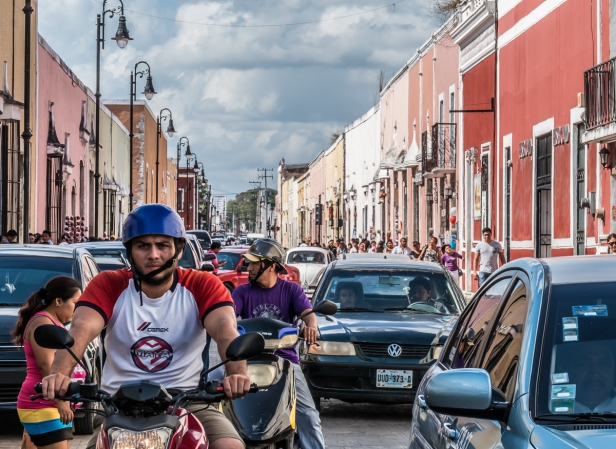

The newly restored Parque Principal, or town square, is a few steps away.
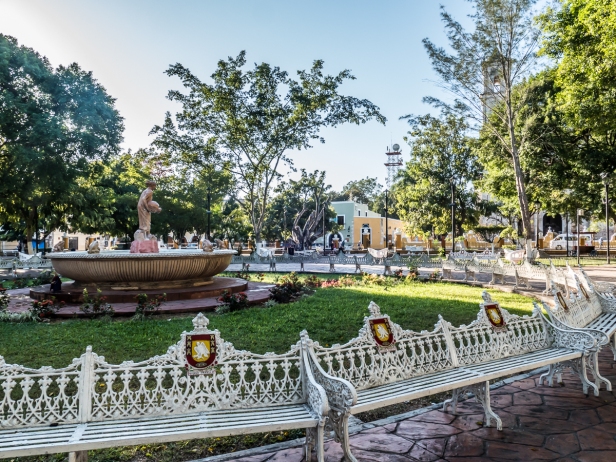
Valladolid is in the north end of the Yucatan Peninsula, about half way between the state capital of Merida and the tourist resort town of Cancun. We’ve chosen twelve days here for its proximity to places we want to visit: Inca ruins, Rio Lagartos, and various different cenotes. At the same time it’s lovely to be in a city that is vibrant with life. Initially Valladolid’s beauty is not obvious. There’s too much traffic on both the streets and sidewalks to see it at first but slowly the town speaks to us. Buildings in the softest candy colours line the streets. I spy them through the crowds and one day set out early, before the town is awake, to capture the beauty of this Spanish colonial town founded in 1543.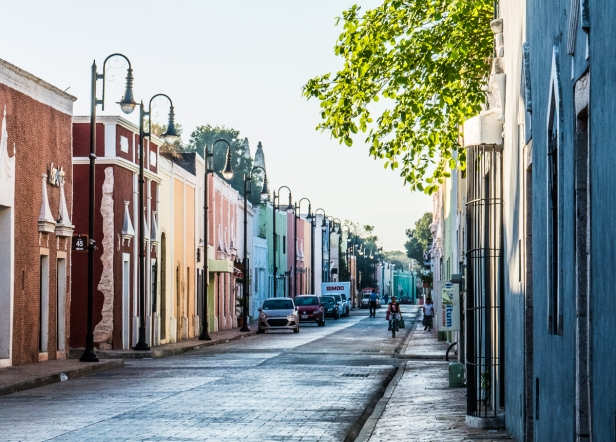
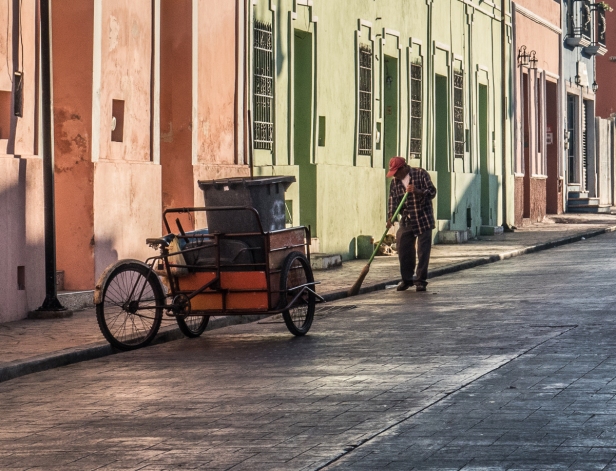


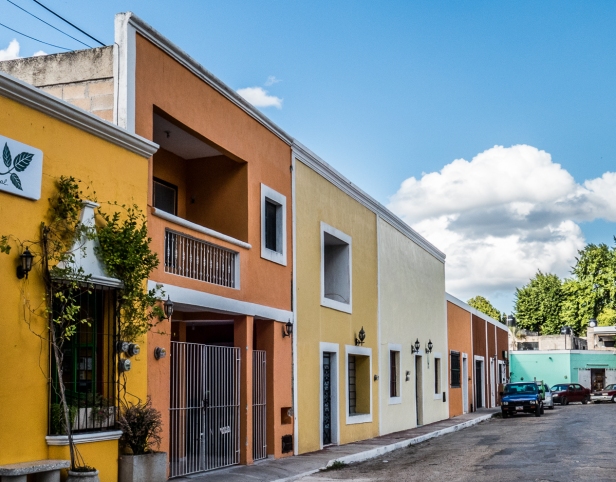
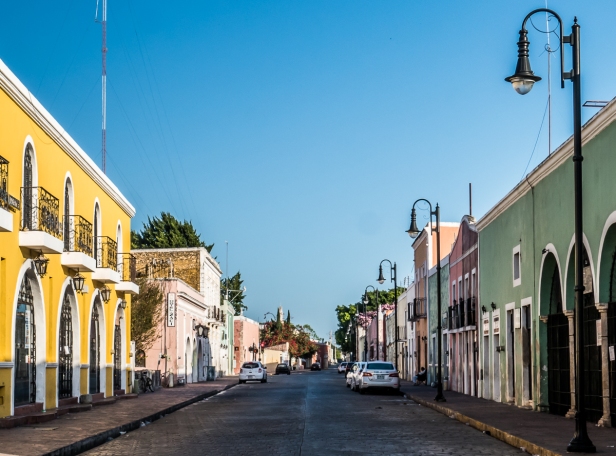
The Franciscan Cathedral of San Gervacio dominates one side of the town square.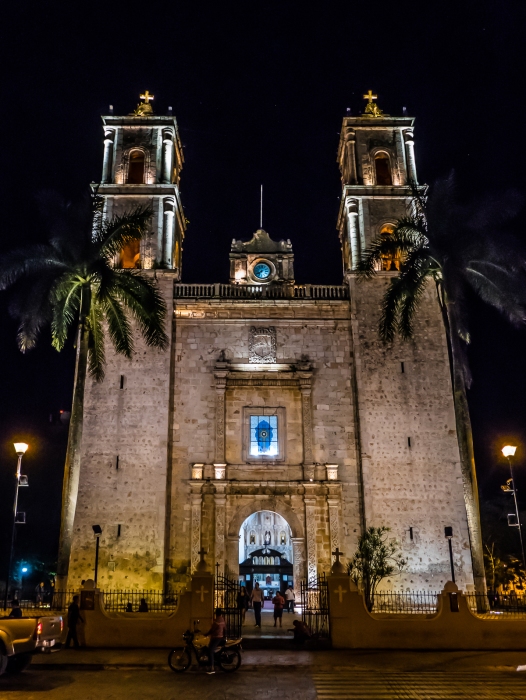
Just past the cathedral, half a block from home is our favourite restaurant. We eat in a leafy courtyard where the grackles screech and whistle in the treetops. For dinner we might have melt-in-the-mouth grilled fish or the local Mayan dish of chicken pibil, and for breakfast red chilaquiles with eggs.
Down the road a bit, just past our favourite café, these two ladies graciously welcome customers into a store filled with colourful Mayan artefacts.
For all its beauty Valladolid is unpretentious, and laid-back despite its fractious history. In 1847, having been suppressed by the descendants of the Spanish Conquistadors for about three hundred years, and outnumbering them by up to as many as five to one, the indigenous Mayan population rioted. They killed eighty people of the ruling class, those of European descent. After a Mayan nobleman was shot by firing squad the riot escalated into a general uprising, and the city and surrounding area became the centre of the intense battles of Yucatan’s Caste Wars. The Spanish leaders had been reluctant to join the Mexican Union in the north but in exchange for agreeing to do that they received the armed help needed to finally put down the rebellion.
The entire story of Valladolid’s history, including the Caste Wars, is told in a brilliant fifteen-minute movie projected onto the walls of the Convent of San Bernardino de Siena, which saw plenty of the action.
We first explore the convent and it’s adjacent church, during daylight. The stately building, in understated Franciscan style, was completed in 1560.
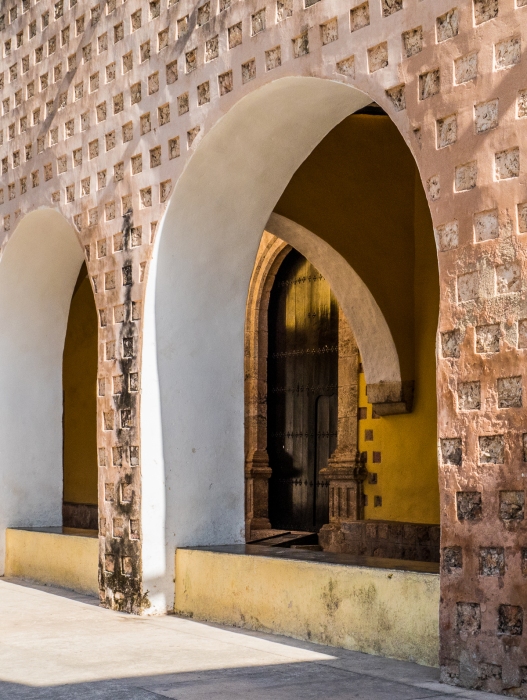
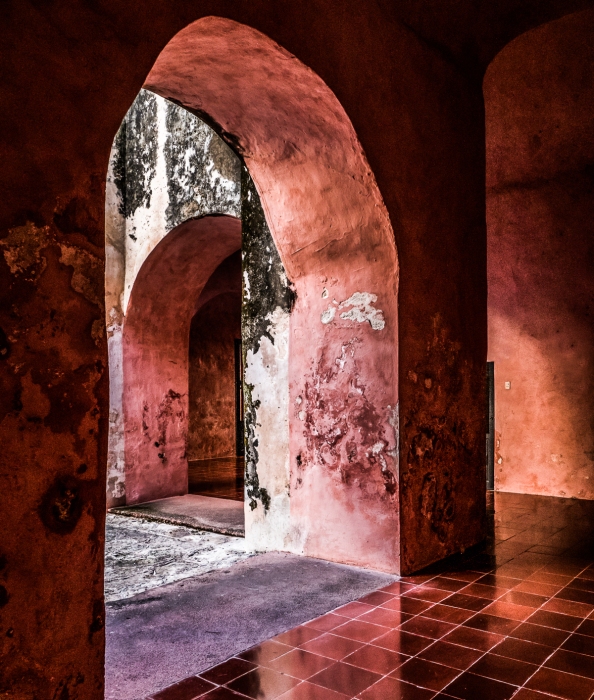
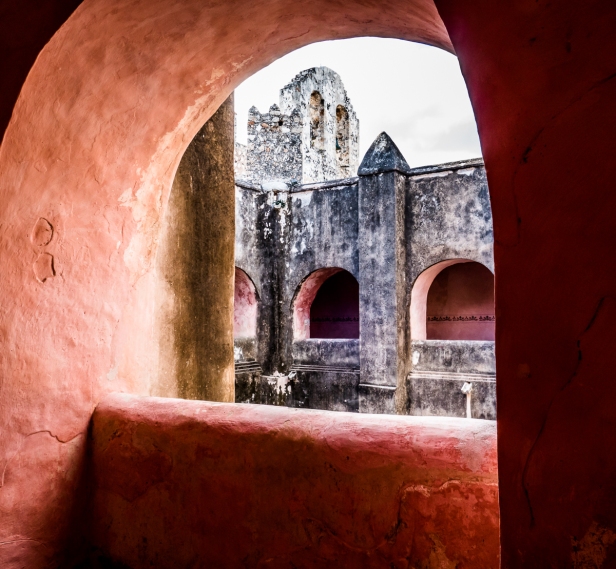

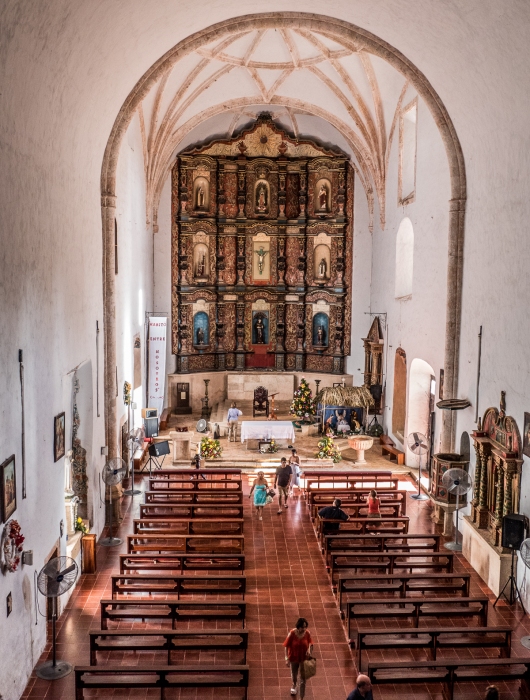
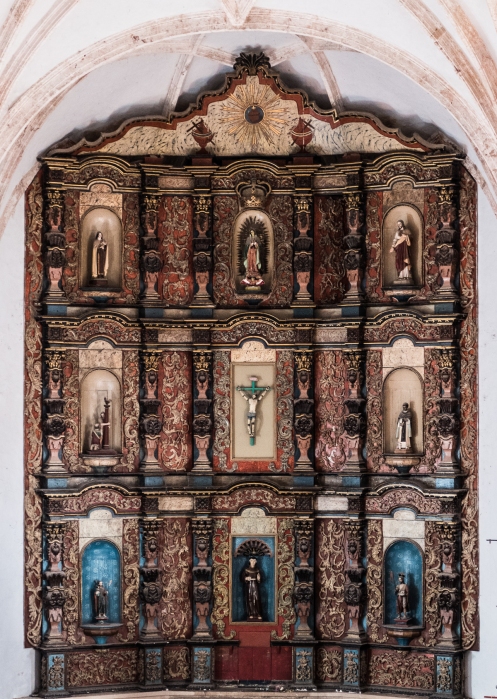
We return on New Year’s Eve hoping to see the film that is projected onto the entire front wall of the building but instead find we’re attending a Catholic mass to bring in the new year.
We walk slowly home, getting some sweet glimpses into ordinary life along the way. People leave their doors open for the cool of the evening, sometimes moving their chairs out onto the sidewalk.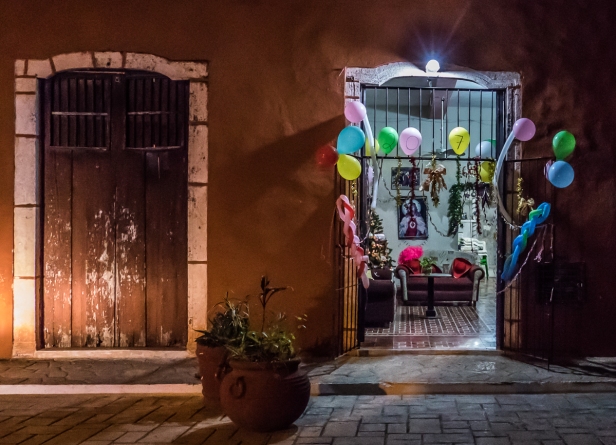
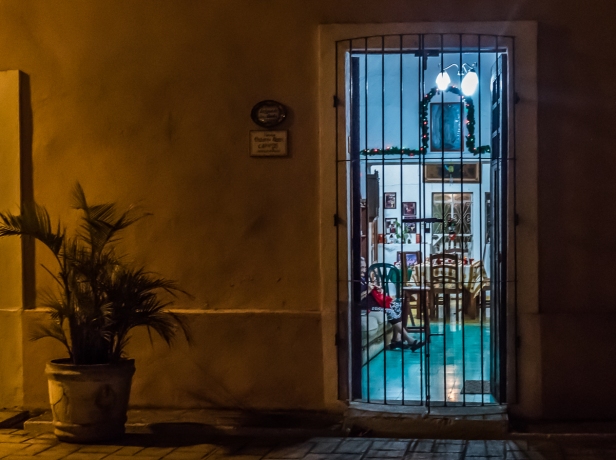
We return a couple of nights later. Don finds a seat on the stone wall that fences the lawn, and I find a huge concrete bunker that I can climb up and stand on. The film is shown twice, first with Spanish narration and then with English. It’s worth staying for both showings. It astonishes and delights us the way the film fits the façade of the building. How did they do that? They show Mayan life before the arrival of the Spanish.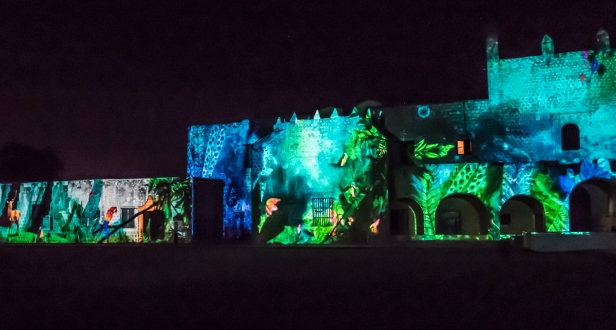
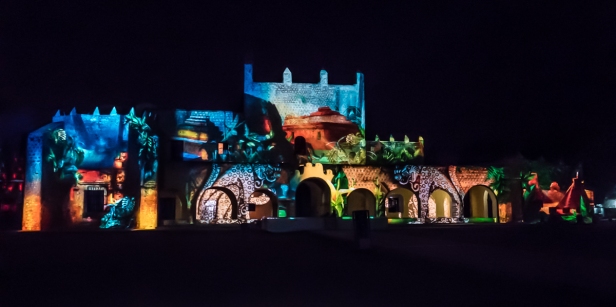
The arrival of the Conquistadors.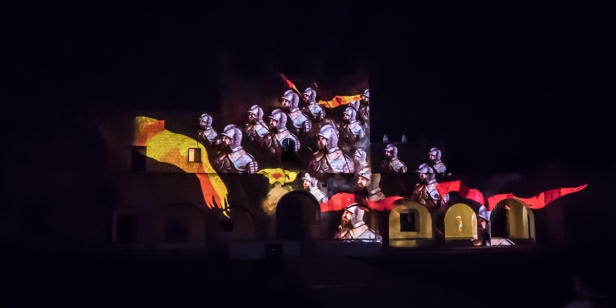
The arrival of Christianity.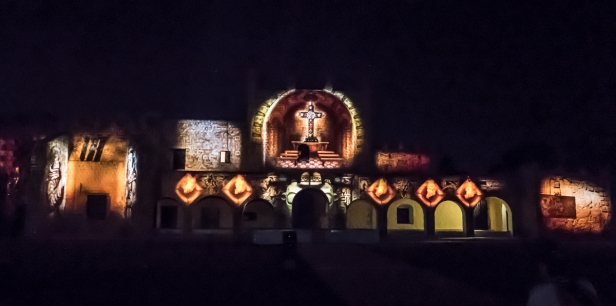
The first mechanized weaving factory bringing prosperity to the area.
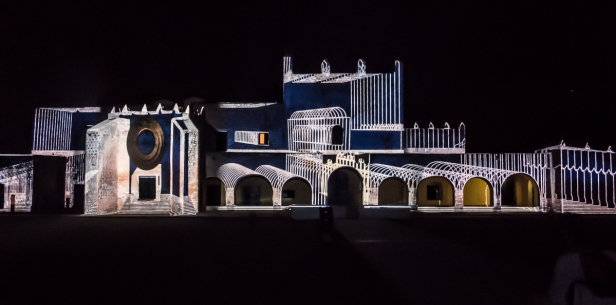
It is constantly moving and changing. Trains arrive and travel the entire width of the building, hawks fly across, wagon wheels move from one side to the other, one scene morphs into the next, never static, and all the while the narration tells the story.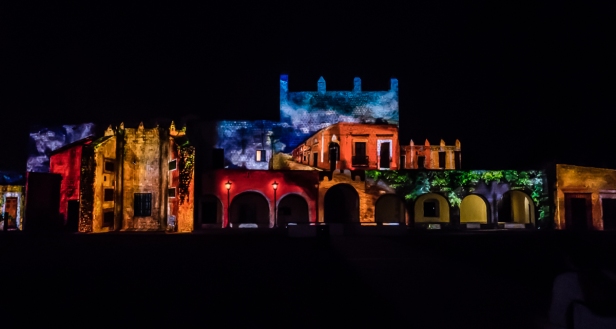
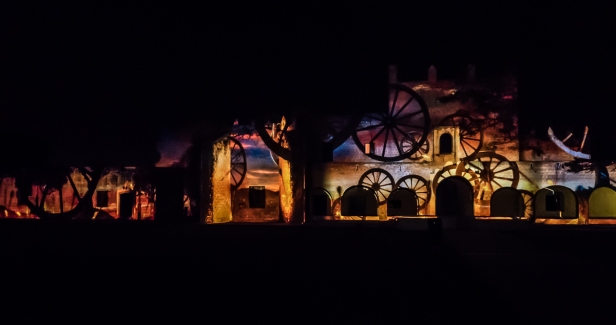
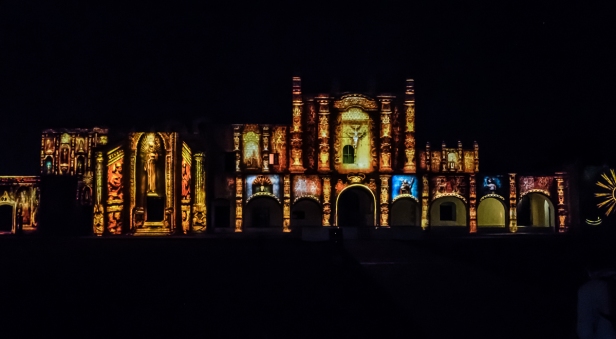
The final scene is a celebration of Mayan culture and arts.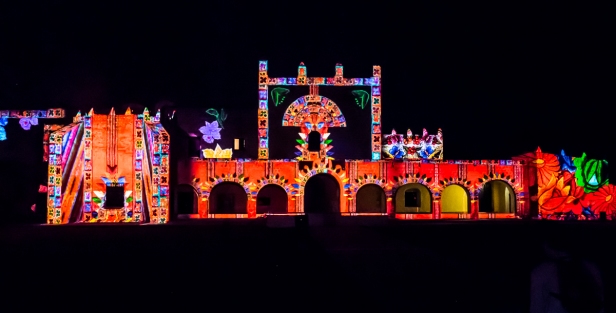
With Valladolid as our base we visited four cenotes, two of the more prominent Mayan ruins, and an extraordinary private collection of Mexican folk art. All to come in the next couple of posts.
All words and images by Alison Louise Armstrong unless otherwise noted
© Alison Louise Armstrong and Adventures in Wonderland – a pilgrimage of the heart, 2010-2016.

fantastic pictures!
LikeLiked by 1 person
Thank you so much.
Alison
LikeLiked by 1 person
What a difference the absence of crowds makes! It looks so charming. But the people give it life. Have a great time there Alison and Don!
LikeLiked by 1 person
Yes, the streets were very different early morning before the town was awake. It looks so elegant and sophisticated, but then the day got going and it’s all ordinary folk going about their lives, unpretentious and laid back. We enjoyed it there. We’re now in a small town in another state for a local festival. Fun!
Alison
LikeLike
Sooooooo! Are you going to share the name of your digs and the cost or is it top secret?
LikeLiked by 1 person
Chuckle. I rarely publish those kinds of details, though maybe it’s time I started doing so. We stayed at the Hotel San Clemente
http://www.hotelsanclemente.com.mx/index_ing.htm
We paid about $50 per night. Note though that all amounts here are in Canadian $ ‘cos that’s the currency we live in.
Alison
LikeLike
I’m impressed that the owner of the apt refunded your money.. That’s great, and great that you found a much-better place.
The images just get better and better – wow, what a delight for the senses — if they’re so stunning in small image formate, it must have been amazing to see in person.
thanks for keeping us informed!
LikeLiked by 1 person
Thanks so much Lisa. Yes, the streets of Valladolid are pretty amazing seen in person, and that movie projected onto the convent was spectacular.
We also were impressed that the guesthouse owner so readily refunded our money. I’m thinking he’s used to young poor backpackers so wasn’t surprised when us elderly folk (i.e. with a bit more money at our disposal) opted out. We were both surprised and very grateful. We thought we’d have to pay for at least one night, but he gave it all back to us.
Alison
LikeLike
Gosh Alison, your photos always blow me away! That film projection looks simply amazing! 🙂 So glad you found a better place to stay. Lack of grime, and a bit more space, plus a/c, makes everything so much better, doesn’t it?!
LikeLiked by 1 person
Thanks so much Danila. The film projection was unexpectedly spectacular! Everything you say – lack of grime, space and a/c made a huge difference. Oh, and a seat on the toilet!
Alison
LikeLike
Hmmm, let me think….$1000 per night or $30??? Guess I’d have to pick $30 too! So glad you were able to escape that dreadful sounding place and find something much better! As always, gorgeous photography and wonderful writing! Hugs to you both!
LikeLike
Thanks Kaye. We too were glad to escape that dreadful place. It’s the first time in all our travels that we haven’t been able to find something suitable online ahead of time.
Hugs to you too.
Alison
LikeLike
Amazing photographs. Makes me want to put Mexico on my list of places to look for work… I am sure there is demand for English teachers.
LikeLike
Thanks so much Lieve. Yes I’d imagine there’s demand for English teachers in Mexico. This is our fourth time here and we highly recommend it.
Alison
LikeLike
The beautiful photos of the street in the early morning hours are so reminiscent to me of the city of Trinidad in Cuba! The colors, the architecture, very similar. Lovely shots capturing the place waking up…..
Nothing like arriving to a dump! Definitely why we never book more than 1 night ahead. Things are so often misadvertised and it is really hard to tell what a place is like online. It can be fun too to leave your bags at a cafe or hotel upon arrival and go and find a good spot…much like Don ended up doing. Glad you got your refund.
I love the photographs and architecture of the church! Those arches!!
Peta
LikeLiked by 1 person
Thanks Peta. I’m so pleased to hear that Valladolid reminds you of Trinidad – we’re planning on being there very soon. We’ve booked our flights to Cuba – going on Feb 13 for 2 weeks and Trinidad is on the agenda.
We were surprised and grateful to get a full refund. He didn’t even hesitate. We usually book ahead for as long as we want to stay in a place. This is the first time in all our travels that it hasn’t worked out. A first time for everything eh!
Alison
LikeLike
Hi Allison and Don, Beautiful post! Your images are vibrant and interesting. Enjoy your time there.
LikeLiked by 1 person
Thanks so much Jane. It’s a wonderful compliment coming from you. We’re now in a very small town for a local festival. We’re loving Mexico, it has so much to offer.
Alison
LikeLiked by 1 person
Gorgeous photos, can’t get over the changes since 1972!!
LikeLiked by 1 person
Thanks Cindy. I can’t even imagine what it would have been like back then!
Alison
LikeLike
I love the convent pictures. Think Valladolid is going on my list of places to visit!
LikeLiked by 1 person
Thanks Tracy. The convent is a quite wonderful building, and Valladolid is definitely worth a visit.
Alison
LikeLike
Yikes to the rough start at the guest house. Yes the toilet seat, or lack there of, would have put me over the edge. Loved seeing the photos of this vibrant place.
LikeLiked by 1 person
Thanks Sue. Apart from the unfortunate guesthouse at the beginning we enjoyed Valladolid – sooo much more than Merida!
Alison
LikeLiked by 1 person
I love the plug for duct tape, and pleased you didn’t have to use it. Your supply lives for another time, another use. As always, thank you for the beautiful photographs and commentary.
LikeLiked by 1 person
Thanks so much Anne. We enjoyed Valladolid. And yes, we never travel without a little duct tape. I wish I’d made a list of all the different ways we’ve used it.
Alison
LikeLike
Alison, your images are so wonderful!!! So many thanks for sharing them here, they completely transported me to that town! ❤ Too funny about the duct tape and the toilet seat. At least there was a toilet. 🙂 I had been in plenty a place where there is just a hole in the floor. Looking forward to reading more about your adventures.
Peace,
Kristina
LikeLiked by 1 person
Thank you so much Kristina. I’m glad you enjoyed a little visit to Valladolid. I too have stayed in places where the toilet was a hole in the floor, back when I was much younger, but I won’t do it anymore. It’s a toilet seat all the way these days 🙂
Alison
LikeLiked by 1 person
Thanks for the trip down memory lane, Alison as we also fell in love with Valladolid and found that it had all the historic charm that was so lacking in Playa del Carmen. Your pictures are amazing and I especially love the film images against the walls of the Convent of San Bernardino de Siena. (They’d make a brilliant photo series!) I remember looking for a place online to stay in Valladolid at the beginning of December in 2012 and not having any luck either. We finally hopped on the bus from Playa del Carmen and took our chances. We found a charmingly simple and clean hotel right off the main square for about $45/night (with Wi-Fi!) and stayed there for a few days using Valladolid for a base like you did. And the Mayan food was delish too! Anita
LikeLiked by 1 person
Thanks so much Anita. We immediately liked Valladolid more than Merida, even with the dire guesthouse and having to find alternative accommodation. I was thrilled to even get pictures of the film projected onto the walls of the convent. I’m glad they turned out so well. I have heaps more. I thought the whole show was really brilliant. Your hotel sounds very similar to ours – right off the main square, and with wifi. It puzzles me that it was then, and still is, so difficult to find accommodation online.
Alison
LikeLike
oh, how I love your posts, they are a real pleasure to read and the photos are once more brilliant!
LikeLiked by 1 person
Thanks so much Ingrid, I’m glad you enjoyed it.
Alison
LikeLike
Your photos are so beautiful, and that projection show on the convent looks amazing! I am happy to hear that you were able to upgrade your accomodations!!
LikeLiked by 1 person
Thanks so much Diane. The film at the convent really was amazing. We’d read that it was worth seeing, but it was so much better than we could have imagined. Really professional. I think we would have not been very happy in that guesthouse for 12 days. I think Don would have rioted! And I’d have grumbled a lot.
Alison
LikeLiked by 1 person
You did a great job of capturing the film at the convent with your camera! I imagine that was difficult.
LikeLiked by 1 person
It just requires a high enough shutter speed – so high iso, low depth of field etc then I make corrections for exposure and noise when editing. Even so I was very pleased with the way they turned out.
LikeLiked by 1 person
No toilet seat as the clincher, I love it! Glad you got out of that dump and found a nice place. I am mesmerized by the “candy-colour” streets and the photo of the street cleaner. Beguiling indeed.
LikeLiked by 1 person
Thanks Caroline. Isn’t it a pretty place?! We just loved it. And we too are very glad we got out of that dump! I can’t imagine having to live in that small stifling room for 12 days.
Alison
LikeLike
I loved seeing the city through your eyes … and am so glad you found a toilet seat!
LikeLiked by 1 person
Thanks Susan, I’m glad you enjoyed it. And we too are glad we found a toilet seat!
Alison
LikeLiked by 1 person
Wow! What an incredible way to show a film. The graphics are fantastic. I suspect you’re going to enjoy Cuba — you’ll find similar architectural details and highlights as you’ve shown here among Valladolid’s streets. Excellent post and wonderful morning light in your photos!
LikeLiked by 1 person
Thanks Kelly. Yes, wow, what an incredible way to show a film. We were quite blown away by it – the way it moved across the whole canvas was amazing, the way each scene morphed into the next, it was really quite brilliant. Those wagon wheels started at the left and rolled across the entire front of the building with more and more added as they went. The scene with the white lines (I never did figure out what it was about) began with a single white line outlining the building, and then more and more appeared to make it look three dimensional. My only complaint was the sound system was a bit distorted making it sometimes difficult to understand the narration. Getting excited about Cuba 🙂
Alison
LikeLike
Amazing a dump like that would even have an on-line listing. That projection scheme looks very cool.
LikeLiked by 1 person
It is amazing that that guesthouse had a listing, and just as amazing that other -nice- places don’t, or not that we could find anyway. The projection scheme was very cool!
Alison
LikeLiked by 1 person
i want to fly away…the colours and your images are so pleasing…i love the red tones…another stunning post Alison…enjoy! smiles hedy
LikeLiked by 1 person
Thanks Hedy, smiles Alison 🙂
We enjoyed Valladolid and behind the crowds I could see this beautiful town so set out early one morning to find it. We later found streets that were quiet later in the day. It’s really a gem.
Alison
LikeLiked by 1 person
have you seen Javier García Moreno Elizondo’s blog….you probably have just i thought i’d share it with you..i love the spaces you show very much…it is a gem i can see…enjoy ! 🙂
LikeLiked by 1 person
I had not seen his blog. Beautiful photographs!
A.
LikeLiked by 1 person
maybe you know the spaces he photographs…both of your blogs show Mexico in such a beautiful light…have a happy day Alison 😀
LikeLiked by 1 person
Same to you Hedy.
LikeLike
You are truly visiting so many amazing place Alison, and ones I never knew existed. I would love to explore more of Mexico. Based on your posts, you’ve truly opened up my eyes!
LikeLiked by 1 person
We love Mexico. I don’t know it gets such bad press in America. I know there have been some problems with the whole drug issue in the border towns, so we steer clear of them. Everywhere we’ve been in Mexico the people have been friendly and helpful and full of life. Just ordinary folk living their lives, loving their families. And their festivals and traditions of dancing are amazing – so vibrant and colourful. There’s so much to do and see here.
Alison
LikeLiked by 1 person
Well keep telling me more about Mexico Alison. I’m keeping a mental list of all the places I’d love to explore there! Do you get around by driving to all the different cities and towns you see?
LikeLiked by 1 person
We travel by bus. The buses range from comfortable to luxury with seats bigger than business class. The bus companies are well run, schedules are kept more or less – sometimes they run a little late but we’ve not encountered anything drastic.
LikeLiked by 1 person
Sounds exciting Alison. Can’t wait to read more!!!
LikeLiked by 1 person
I’m enjoying your Mexico trip so much I don’t even want you to go to Cuba! Except I do want you to go to Cuba so I can hear what you think. I really wanted to add Trinidad to our trip, but we ran out of time; I don’t like dashing from place to place and it was nice to more deeply enjoy our two cities, Havana and Viñales. Gorgeous early morning street photos here. You are going to go nuts with your camera in Cuba!
LikeLiked by 1 person
Thanks Lexie. We so enjoyed Valladolid. I do think I’ll be going nuts in Cuba. We’ve put together an itinerary now. We have 2 weeks – Havana, Viñales, Trinidad, with a day trip to Cienfuegos. Like you we don’t like rushing from place to place.
LikeLike
Sounds perfect! (You got my email about the restaurant, right?)
LikeLiked by 1 person
Yes, thanks so much. We have someone in Cuba who can book it ahead of time for us, but we’ll still go for lunch.
LikeLiked by 1 person
Love all the photos, especially the third one, sunset over town, the night cathedral, and inside cathedral from above! I carry duct tape, too, and a couple nails for hanging mosquito nets in weird countries. I don’t like the sound of your $30/night place, but the no toilet seat wouldn’t bother me…I squat in places like that. I’m kinda upset with myself for becoming such a snob about places to stay. I like staying in nice places these days. But WHO actually stays in a thousand dollar a night hotel? And WHY?
LikeLiked by 1 person
Thanks BF. I was really pleased with the night time cathedral photo. Yeah, we’re not doing the no toilet seat any more, or the hole in the floor toilet, not when we can afford a little more comfort than that. Never have carried nails for mosquito nets. We used to carry mosquito nets until we discovered that everywhere we went that we needed them they were provided. I’m not remotely upset about becoming a snob about where I stay. It’s taken me an entire lifetime to even begin to embrace comfort and luxury. I was the poster child for making do/being tough/eschewing any kind of luxury. No longer! But yeah – why spend $1000 a night. Still I’d love to have the experience of having that kind of money just to see what it feels like.
Alison
LikeLike
I guess I’d rather do a hole in the floor than a no-seat toilet because a hole is supposed to be there, but so is a seat and if there’s no seat, something is amiss there. But me too…give me a marble bath with all the fixtures, please, and all the lux you can find.
LikeLiked by 1 person
As always, your photos brighten up my day. Maybe soon we Americans will be able to tour Cuba on our own.
LikeLiked by 1 person
Thanks so much Steven. I know several Americans who’ve recently been to Cuba. Apparently it’s quite doable now. We go on Feb 13th for two weeks and I’m really looking forward to it.
Alison
LikeLike
I read your story tonight, just as my husband and I have been planning a trip to a place here in Ecuador…a bit lesser known destination, and online the lodging choices are $400 a night or $43 a night, and nothing else. We are not the type to cash in on the obvious tourist hot spot..but, I do wonder what that $43 might not warrant. I suppose it will be part of the experience to find out. I am so glad that you found somewhere better to stay, because from the looks of your photos that first place did not give this place justice. What a very, pretty place you have chosen. And that movie on the wall looks just phenomenal. And the streets looks so clean. I didn’t realize it until this moment, that I think I miss clean streets. You’ve been to Ecuador. You know what I mean! So lovely to take some time to catch up on your stories 🙂
LikeLiked by 1 person
Thanks Stephanie. I’m a bit behind myself. That $43 a night place might be a surprise, and not in a good way. On the other hand it may be okay. Perhaps book only one night and look around when you get there.
We’re really glad we found somewhere better to stay too! And from then on we enjoyed Valladolid very much. And yes, the movie on the convent wall was truly phenomenal! I know exactly what you mean about clean streets! India’s the worst country in the world for that – spectacularly dirty streets. Even poor Cambodia has public garbage bins.
Alison
LikeLiked by 1 person
Loved the photos! Reminds me of the photos of daughter Ann’s visit to Cuba. Same types of colors. Lasers. The things that can be done with projection are astonishing.
LikeLiked by 1 person
Thanks so much keebslac. I’ve heard the same thing about Cuba. I’m so looking forward to going there. Ah lasers! I never thought of that, and know little about it, but yes, what we saw was really astonishing.
Alison
LikeLike
I like your article, very inspiring and thank you for your post
LikeLiked by 1 person
Thank you very much. I’m glad you enjoyed it.
Alison
LikeLike
Wow! What a fantastic light show! How *do* they make the light conform to the shape of the building? It’s the sort of thing I’d watch several times, just to take it all in.
Sure goes a long way towards making up for a lack of toilet seat.
LikeLiked by 1 person
The light show really was amazing. They do it with lasers apparently, though I have no idea how. It was good to see it twice, though it would need more viewings to really take it all in. So glad we also had a toilet seat!
Alison
LikeLike
Interesting, that so many names of places are taken from Spain…
…until I noticed it was Mexico, I was a bit puzzled. 🙂
None the less, both cities seem to be beautiful. 🙂
LikeLiked by 1 person
As far as I can tell the Spanish arrived, conquered, and then just named everything after their homeland, much like most invaders. Almost all the Spanish Colonial cities of Mexico and Central/South America are lovely though there are standouts. The two that come to mind for me (of those we’ve seen) are San Miguel de Allende (in previous posts) and Campeche (in a future post). Both cities are quite beautiful, though Valladolid does rank right up there.
Alison
LikeLiked by 1 person
Yes. I saw some of the posts of Mexico.
I never really made it to Latin America.
LikeLiked by 1 person
The pictures here are remarkable I felt, and the beauty of Valladolid, which you seemed uncertain of at first, really shone through by the end. I could only imagine witnessing in person those images projected onto the building. They were stunning even here in this post. And I loved how that one image looked like an x-ray of the building’s ribs, but used the doorways as their template.
And of course I love that we knew how to build such stately buildings in 1560. The images through the doorways, of the wide columns, the open spaces and the falling light, really spoke to me. Thanks for this beautiful tour of the Yucatan!
Peace
Michael
LikeLiked by 1 person
Thanks Michael. Valladolid is crowded with ordinary life, and a bit crumbly, but those pastel shades captivated me. That movie projected onto the convent was absolutely stunning! I didn’t know what to expect though we’d read it was worth seeing. I was completely wowed by how professional, how creative, it was. Extremely high production values. And yes the building itself is gorgeous – a depth of feeling one rarely gets in modern buildings. I wish I knew better how to put it into words.
Alison
LikeLiked by 1 person
Your photos always gets me! really beautiful 🙂
LikeLiked by 1 person
Thank you so much J&J. That’s such a huge compliment coming from you. Your photos are sooooo brilliant!
Alison
LikeLike
Your pictures are so beautiful! I love the way you have layed out your post! Very easy to read and got me hooked! In fact, I have now added Valladolid to my travel list! Thank you so much for sharing your experiance!
LikeLiked by 1 person
Thanks so much Paige, I’m glad you like the post, and that I got you hooked! It’s the best compliment! The whole Valladolid area is wonderful – there are so many day trips you can do from there.
Alison
LikeLiked by 1 person
It is so good to get back to reading about beautiful places to explore instead of focusing on what is happening in our country. Valladolid looks like the perfect place to explore and to kick back and relax. Looking forward to hearing more Alison!
LikeLiked by 1 person
I try very much not to focus on what’s happening, and give thanks that I’m one step removed. Much better to focus on all the wonderful places in the world! And Valladolid is definitely one of them. I’m glad we had some time there.
I remain optimistic and hopeful. I guess because it’s better than the alternative.
Alison
LikeLiked by 1 person
I wish we were traveling right now. It seems to be too much in our face sitting at home. As soon as the weather here cooperates, we are heading out a much needed escape and some hiking.
LikeLiked by 1 person
Alison, firstly I am so, so glad that you and Don found a better alternative to that awful, squalid guesthouse – staying there might even have ruined your time in Valladolid. Otherwise, the place strikes me as exactly the kind of colonial town I would love. I recall Jeff saying that Valladolid gets quite a number of tour buses filled with day-trippers, though I would never have known that from your pictures. The film projected on the walls of the convent is a real stunner – I don’t know how you managed to take photos with hardly any people in the foreground!
LikeLiked by 1 person
Thanks so much James. I agree staying in that awful guesthouse could very well have ruined our time in Valladolid. I’m so glad we found something better. Jeff’s right – the tour buses arrive from Cancun and Playa del Carmen and park in the main square for an hour or so while everyone piles out and looks at the cathedral, and that’s about all. It’s part of their day-tour to Chichen Itza. It barely affected out time there. Valladolid’s a vibrant busy town, not sophisticated at all, but very down home, and underneath is the beautiful colonial architecture. It’s a great city to base from for Rio Lagartos, Chichen Itza, Ek Balam, and several of the main cenotes. Re the film – people in front were sitting, and I saw a huge concrete “bunker” about 6 ft high – I have no idea what it was for – and somehow managed to climb up on top of it so there was nothing in my way. Amazing film!
Alison
LikeLiked by 1 person
I don’t comment often but have been following along for awhile. You are expert storytellers and your photography tells the story so well also. Honored to be joining you on your journey vicariously!
LikeLiked by 1 person
Thank you so much Pamela, what wonderful compliments. And thank you for joining in on our travels. I hope you enjoy the continuing story.
Alison
LikeLike
The pictures are fantastic! Love them
LikeLiked by 1 person
Thanks so much moosylicious. I’m glad you like them. And thanks for following and all the likes!
Alison
LikeLiked by 1 person
The pictures are fantastic! Love them.
LikeLike
Thanks so much. Sorry I took so long to reply! Erratic internet in Cuba.
Alison
LikeLiked by 1 person
I was just there for five days and LOVED it! One of my favourite Mexican cities – gorgeous buildings, friendly people, great food and located to so much cool stuff
LikeLiked by 1 person
Thanks for your comment Katie. Good to hear you enjoyed Valladolid as much as we did. Such a lovely city, and so close to many activities.
Alison
LikeLike